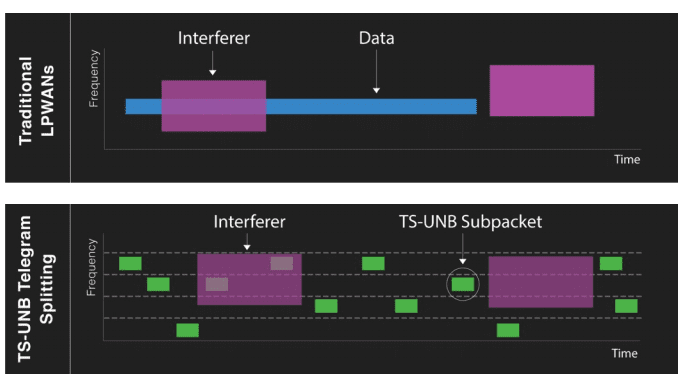BehrTech is a Toronto-based industrial IoT connectivity provider claiming a “disruptive” streak in the burgeoning low-power wide-area (LPWA) networking market. The company has just issued a (privately commissioned, independently researched) report that says its novel telegram-splitting ultra-narrowband (TS-UNB) technology is better than LoRaWAN.
Indeed, it claims its technology, called MIOTY, is better than any of the cellular or non-cellular LPWA offerings currently available for industrial applications. But the new study makes comparison with and takes aim at LoRaWAN, specifically, on the grounds it is more robust in “real-world industrial environments” with high levels of interference from other systems and devices.
(We are running here, almost unchecked, with its knockout claims on the grounds its technology is novel, and its rivals have enjoyed plenty of coverage in these pages already – a detailed commentary on the new battle between LoRaWAN et al for supremacy in the LPWA space is available here in serialised form, and here as a downloadable report).
MIOTY is the “first and only” technology to comply with the new TS-UNB specification from the European Telecommunications Standards Institute (ETSI), developed to replace the Wireless Meter Bus (M-Bus) standard that has underpinned smart metering in Europe, as well as in certain markets in Asia and Latin America.
The technology – originally developed by the Fraunhofer Institute for Integrate Circuits (IIS), and subsequently licensed to BehrTech – is presented as a low-throughput tech for “last mile” industrial communications. As such it goes up against the likes of LoRaWAN, Sigfox, NB-IoT, and LTE-M, variously pushed by their backers as springboards for industrial IoT.
BehrTech’s MYTHINGS software platform and sensing products, using the MIOTY standard, can be “easily” retrofitted to industrial setups, the company claims. Customers are yet to be announced, but has “real-world mining use cases”, it says, and is gaining traction in other industrial sectors besides. It has so far confirmed partnerships with Microsoft, Advantech, and Hitachi, among others.
Thomas Lauterbach, professor at the Nuremberg Institute of Technology, and author of the LoRaWAN comparison, claims a “significant difference in the quality of service” for BehrTech’s MYTHINGS family, compared with equivalent LoRaWAN based starter solutions.
TS-UNB, as defined by ETSI, splits the data packets to be transported in the data stream into small sub-packets at the sensor level. These sub-packets are then transmitted over fluctuating frequency and time. An algorithm in the base station permanently scans the spectrum for MIOTY subpackets and reassembles them into a complete message.

BehrTech explains: “Thanks to built-in redundancy, up to 50 per cent of the sub-packets may be lost in transmission, without reducing the information content. The radio standard thus achieves a unique robustness against interference with a great network capacity and high power efficiency due to the very short ‘on air’ times.”
A short video explaining telegram splitting is below.
Crucially, in terms of the comparisons BehrTech is making, the fact the technology is based on a standard, from ETSI, makes industrial IoT solutions easily scalable, the company reckons. A single MIOTY gateway, running on commodity gateways and transceivers, can scale to handle up to 100,000 sensor nodes and 1.5 million messages per day.
MIOTY sensors operating in license-free sub-gigahertz spectrum work within a radius of up to 15 kilometres of the gateway, depending on the geographical density – even in inhospitable environments such as mines and refineries, it says. Plus, there are no network fees.
Michael Schlicht, head of the communication systems at Fraunhofer IIS, comments: “The lack of standards has been a primary barrier to worldwide IIoT scalability. We worked closely with globally-recognized standards body ETSI to introduce this revolutionary MIOTY communication technology to the market.”
BehrTech, unsurprisingly, calls it a “game changer” for the industrial IoT space. “Especially since the technical specifications surpass that of any other solution in use today by an order of magnitude,” said Albert Behr, chief executive at BehrTech, and the man the company is named for.
The Nuremberg test evaluated the network performance of MIOTY and LoRaWAN over both a 60-minute period and a four-hour period under various external interference conditions based on the LPWAN Interference Model Standard developed by IEEE. Results were measured by Packet Error Rate (PER), which refers to the percentage of unsuccessful message transmissions.
Four interference scenarios were used to demonstrate different levels of signal density. The study focused on the dense level scenario which has an interference level equivalent to real-world Industrial IoT environments.
Lauterbach comments: “Observing both networks at the same signal power, MYTHINGS successfully delivered all messages while the LoRa network lost more than 10 percent of its messages. Even when signal power was increased, there was a four to five percent packet error rate in the LoRa system.”

But Adarsh Krishnan, principal analyst at ABI Research, observes the technology is brand new, and the market is busy already. “MIOTY offers better coverage and capacity to manage high densities of end-devices, and is positioned as a successor to Wireless M-Bus in the utility market, and in other industrial IoT use-cases,” he says.
“However, MIOT is still in very early stages of market development. We are yet to see wider industry adoption. Finally, as LPWA technologies such as Sigfox, LoRaWAN, NB-IoT, and LTE-M continue to rapidly expand their public network coverage footprints, it will be interesting to see how Mioty differentiates itself, or whether it will be limited to private network deployments addressing smart metering and industrial ioT applications.”
BehrTech is looking for partners, system integrators, and resellers to deliver fully-integrated industrial IoT solutions based on the technology.
A marketing graphic, authored and supplied by BehrTech, sets out a case for MIOTY/MYTHINGS versus LoRaWAN.


